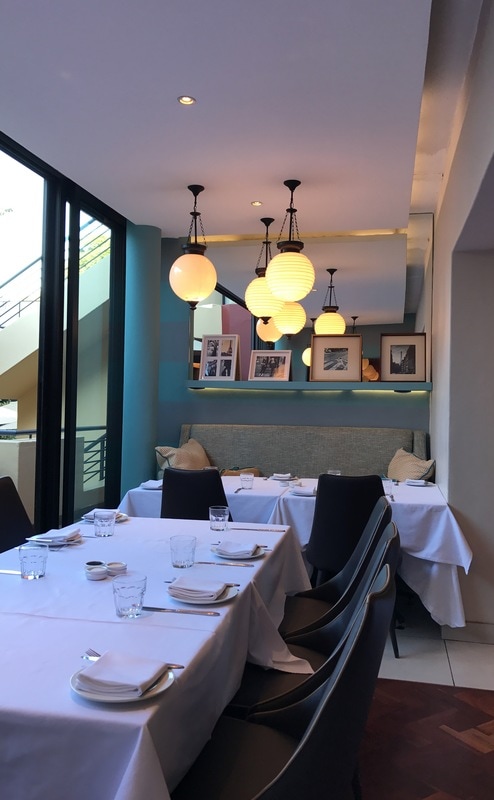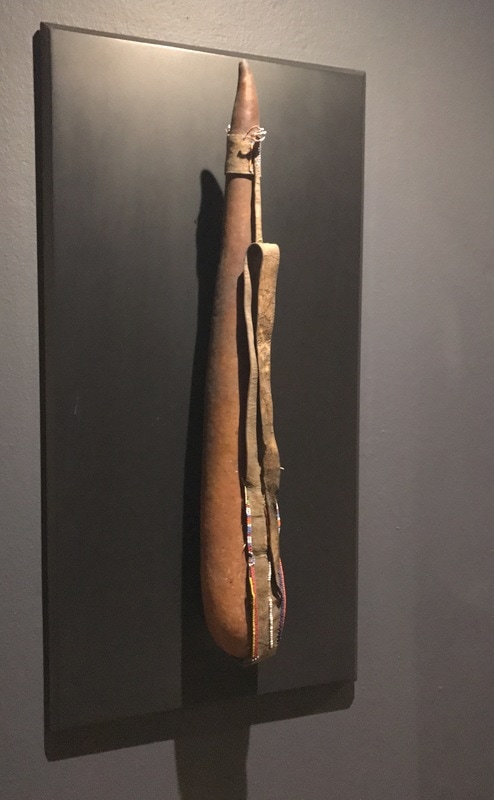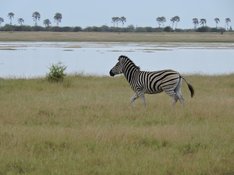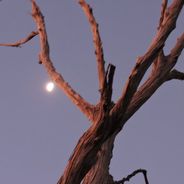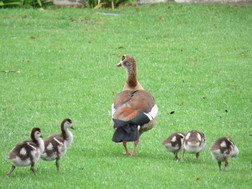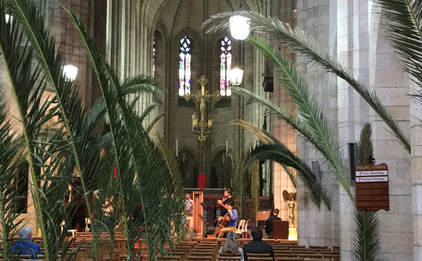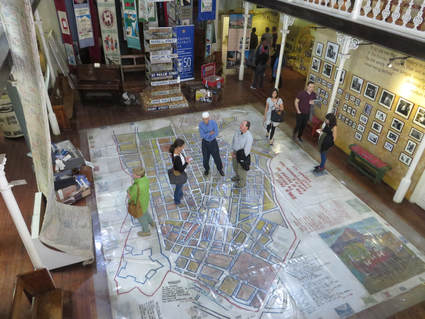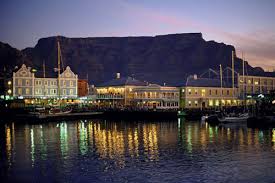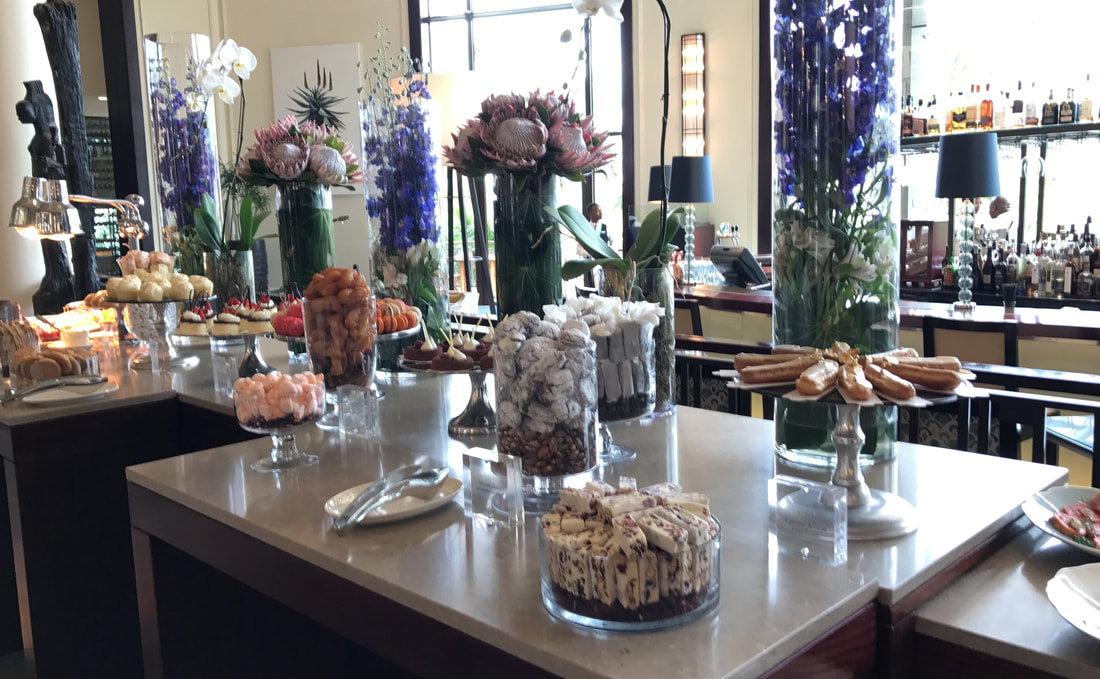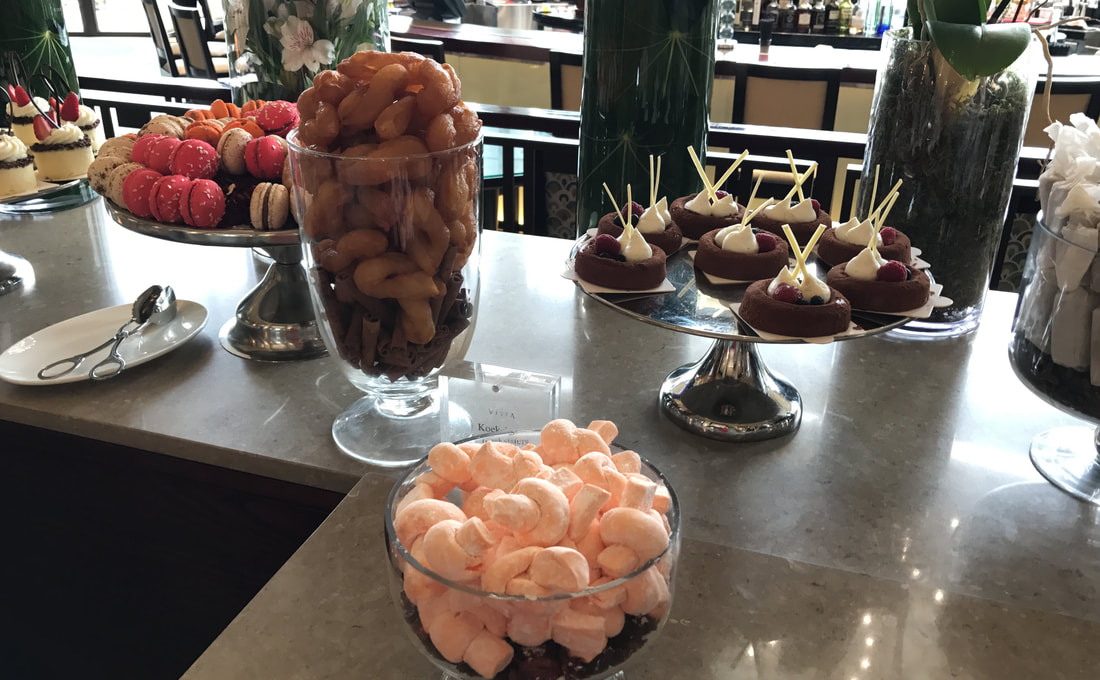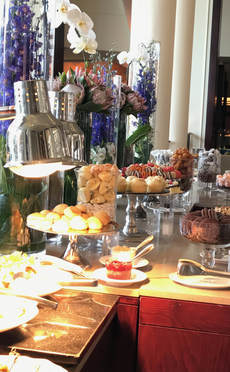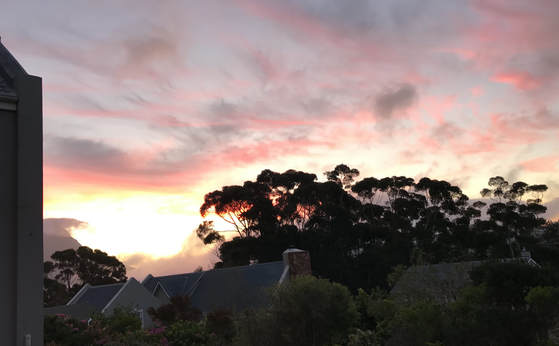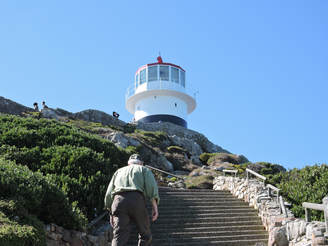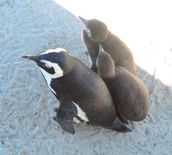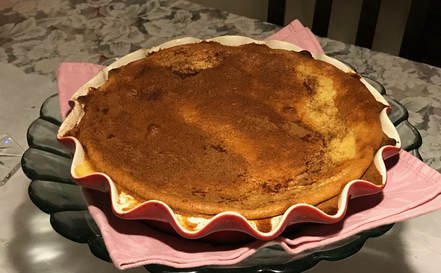Our time in South Africa focused on the areas around two of the country’s major cities—Johannesburg and Cape Town. As our plane approached, my first view of South Africa reminded me of a flat and even hazier version of California—golden fields and grasses dotted with bushy green trees, maybe acacias, and some scrubby pines. Unfortunately, the Johannesburg airport did little to lift our weary spirits or make us feel even a little bit welcome. The building is old, grimly gray, poorly lighted and claustrophobic, with heavy, low ceilings held up by squat square pillars covered with gray tiles. An ironic blessing was the fact that when we finally arrived at customs, the officers were standing in two large circles, facing inward and talking loudly among themselves, utterly ignoring the arriving passengers.
|
On the concrete walls
Of Johannesburg airport
Hang weaver birds’ nests.
|
|
A taxi took us past generic looking new buildings and business districts in this vast metropolitan area of more than seven million people. We passed a surprising number of brick buildings that struck me as out of place in the African setting. I thought that perhaps the Dutch or the British had introduced brick as a building material although the current population is clearly primarily native African. Our destination was the Ten Bompas Hotel, a charming little boutique hotel in a tree-lined neighborhood which appeared to be an embassy row.
The quiet, friendly little hotel had an old fashioned, almost Georgian décor with European style couches and chairs upholstered in plaid earth tones of ochre, brown and gold, evoking the colors of the African landscape we had glimpsed from the plane. Our room had some good looking African art on the walls, framed baskets and weavings in the same colors as the furniture. Our room was actually a very comfortable suite, and the furnishings gave us a hint as to the European version of the South African weather and life style. We had a living room with a large dark wood desk and a glassed, china cabinet-like liquor cupboard filled with bottles of hard liquor and a wood burning fireplace. The sleeping area contained a large bathtub with a steam shower and an outdoor patio with views of the peaceful, private garden filled with pine trees and pigeons.
The food at the Ten Bompas was remarkably good. Little bowls of Asian style noodles with vegetables appeared in our room in the evening, apparently just a little snack from the management. We also loved our breakfast and appreciated the friendly service from the very gracious staff. We enjoyed cappuccino, yogurt with fresh fruit and granola and freshly made juice, a wonderful blend of beet, carrot, ginger, apple and orange. We also indulged in the best oatmeal we had ever eaten. It contained peanut butter, honey and dried prunes and pears macerated in rooibos tea. We were well aware that we were not in the “real” South Africa, if there is such a place, but we enjoyed the comforts of the Ten Bompas nevertheless, as though we were in a very nice little Dutch hotel.
Wayne had arranged for us to take a road trip out into the countryside to visit a UNESCO World Heritage Site called the Cradle of Humankind. Our local guide, a young man named John, arrived in a Toyota van to drive us to this paleoanthropological site about fifty kilometers northwest of Johannesburg in the province of Gauteng. Along the way, we passed lots of new suburbs, car dealerships, a Microsoft campus and other signs of economic growth. As we eventually reached the countryside, I noticed many pine trees that appeared to be newly planted. John explained that pines are not native to South Africa and that much of the natural landscape had been deforested to accommodate various commercial ventures and were now being re-planted, not necessarily with native trees. He did point out several Jacarandas, the national tree of South Africa.
Although the landscape appeared to be a mix of farming and natural habitat, John told us that the Big Five South African animals: elephants, lions, cheetahs, zebras and buffalo do live in the area we were passing through. We saw a few zebras, some springboks and a monkey and noticed several wild animals in the same vicinity as domesticated animals.
|
In a cow pasture,
A zebra and an ostrich
Join the quiet herd.
|
|
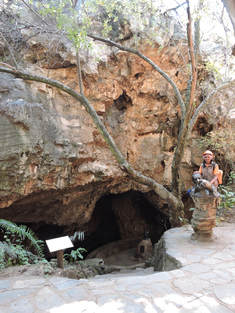
At the Cradle of Humankind, we walked through the Sterkfontein Caves where some of the oldest human fossils were found. Walking through these caves was no easy task, as the excursion included very steep and narrow stairs, low ceilings and areas where we had to scoot along on our bottoms through narrow tunnels, bent completely in half. It was worth the discomfort, as we reached the site where a more than two-million-year-old fossil, nicknamed Mrs. Ples, was discovered in 1947. Fifty years later, an even older fossil, perhaps as old as three million years, was also found in these caves. It was discovered as a nearly complete skeleton called Little Foot, and we visited the site where his remains rested for so very, very long.
We also toured nearby Maropeng, an interactive museum and World Heritage Site built as a large mound covered with sod. This museum provides comprehensive information about the development of humankind over millions of years, based on archeological discoveries and ongoing studies in Africa. Displays which I think children would have loved included a boat ride and a strobe lighted vortex, which was visually stunning, though I did not quite grasp its educational purpose.
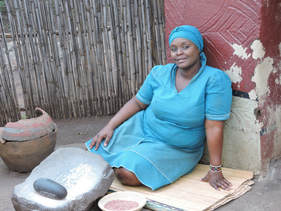
Before returning to Johannesburg, we made a stop at the Lesedi Cultural Village, a visitors’ center that features information about five of the tribes that lived in the area: Zulu, Ndebele, Sotho, Pedi and Xhosa. A film provides information about the origins of these cultures, and guests are then escorted on a guided tour of the individual “villages” that reenact the housing, styles of dress and customs of each tribe. Local people in tribal attire lead the tours. The experience concludes with energetic dancing and drumming in the various tribal styles. While Lesedi Cultural Village does provide some educational opportunities, I felt that it leaned heavily toward commercial tourism. In one of the villages, a woman was sitting in front of a loom to demonstrate traditional weaving techniques. However, I noticed that she was not really weaving at all, and as soon as the guests left for the next village, she got up and walked off. At the next stop, a woman who was supposed to be demonstrating how to grind corn with a stone mortar and pestle was not at her post when the tourists arrived, and after her tardy arrival made only the most half-hearted effort to grind a little corn. It was a little disheartening to observe that the “tribal people sharing their culture” were just employees who were not very excited about their jobs.
|
|
The yellow crescent
Moon of South Africa glows
As the cattle rest.
|
After a long day out in the country learning about pre-historic and more recent human life in South Africa, we returned to the cozy Ten Bompas for dinner in their excellent restaurant, the Winehouse. I enjoyed a three-course meal of gazpacho, an intermezzo of cassis sorbet with crumbled meringue, cauliflower with truffled macaroni and cheese, and a divine dessert of dark chocolate pudding on shortbread with caramel. Wayne relished his meal of pork belly with gorgonzola and figs. Again, we were reminded that South Africa is both a European and an African country.
We learned that Johannesburg is a relatively young city, having been established only in 1886 when gold was discovered on a farm in the area. Today, it is one of the world’s leading centers of commerce. Although gold mining no longer takes place in the city, most mining companies still have their headquarters in Johannesburg. The city also has Africa’s largest stock exchange, and is home to heavy industries such as steel and cement production as well as banking, real estate companies and retail outlets and shopping centers. Tourism, however, is not Johannesburg’s primary industry.
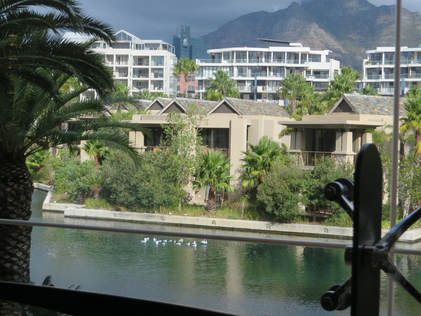
Our next destination, Cape Town and the surrounding area, provided quite a contrast to sprawling, young and commercially oriented Johannesburg. Cape Town, with its lovely coastal setting attracts far more visitors than Johannesburg. In 2014, Cape Town was named the best place in the world to visit by both the New York Times and Britain’s Daily Telegraph. Established in 1652 as a Dutch outpost to provision trading ships sailing around Africa, Cape Town is a multi-cultural destination with a long and complex history. Our hotel, the One and Only, was located right on the waterfront in a very upscale shopping and dining area. The cool weather, hilly seaside terrain, sophistication and diversity of Cape Town reminded me of San Francisco, my favorite American city.
On arrival, we decided to seek out a truly African restaurant for dinner, as our previous meals had been European inspired. Wayne found a place called Mzansi, which was highly rated on Trip Advisor. Uber took us there, and it turned out to be located in one of the townships, the South African euphemism for a segregated slum populated only by black South Africans who live in extreme poverty. The townships seem to be left over from the old apartheid days when the races were strictly separated by law, and not much seems to have changed since. However, since America has an almost identical history, I will pass no judgments lest I be accused of hypocrisy, except to say the obvious: All lives matter.
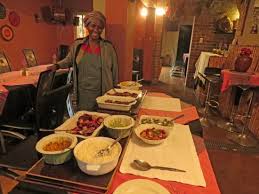
As it turned out, we ate some of the best food in all our time in Africa at Mzansi and met a lot of interesting people. The restaurant is in the home of the owner and chef, who was born in the house. Her front room is set up with a long, communal table, able to accommodate about twenty, where all the guests eat together. The food is served as a buffet. Wayne and I were the first to arrive, so we had to wait for the other guests. The hostess and her staff were extremely hospitable and made us feel at home. Her restaurant seemed to be a neighborhood project with local women working in the kitchen cutting up vegetables, teenaged boys hanging around in the street in front as security guards, an artist working on his projects in the vestibule and a band playing in the adjoining room.
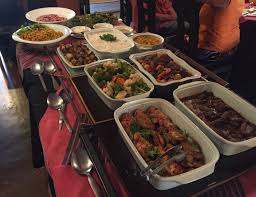
The other guests, all of whom (except us) appeared to be in their twenties, were quite an international lot. There was a group of young people from mainland China, two sisters from Denver, their friend from Norway, and others from various places around the globe. When the food was finally placed on the buffet table, I was delighted by the freshness and variety. As a vegetarian, I was in heaven, but a very tasty looking beef stew was also on the menu, as was fried chicken. Although the food we were served was clearly African, the ingredients were the same as those at any church supper or potluck in the American south.
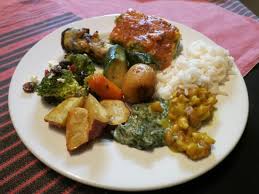
Here’s what we ate: lettuce and tomato salad, fresh broccoli and cranberry salad, coleslaw, baked beans, corn stew, creamed spinach with mushrooms (my favorite,) rice, crispy roasted potatoes, eggplant slices rolled up with chunks of pumpkin inside and the chicken and beef stew. Our dessert was served later, and it was a divine Malva Pudding with warm custard. For those of you who read all of my monthly blogs, you may recall that I included a recipe for Malva Pudding with Custard in my July 2017 blog on our adventures in Botswana. Malva Pudding is the go-to dessert throughout southern Africa.
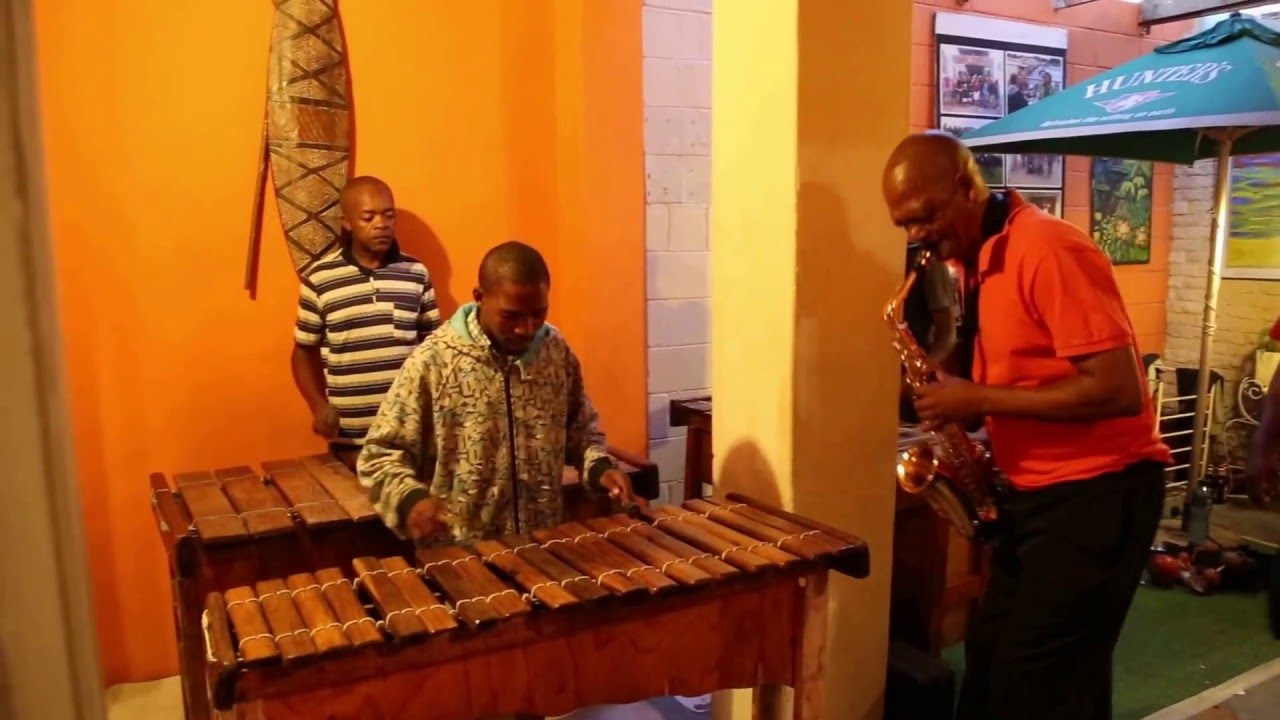
As we ate, the band, which seemed to be a group of neighborhood guys, played African style jazz. There was a saxophone, two marimba phones and two drummers. When we finished eating, our hostess told us her life story, which was indeed a story that needed to be told. Some of the young people at the dinner might not have been all that familiar with the history of apartheid in South Africa, and they certainly got a history lesson. Among other details, our chef/ hostess told us how her husband was arrested and put in prison, like Nelson Mandela, for protesting the government’s oppressive racial policies.
After his wife’s very dramatic monologue, her husband joined us and invited everyone into the next room to have some fun playing the marimba phones and singing. The young international crowd were good sports and had a great old time.
Our sumptuous breakfast buffet the next morning at the One and Only provided an interesting contrast. This unbelievably abundant spread included the expected breads, eggs and pastries such as hot cross buns and almond croissants, but also oysters and a huge round of parmesan cheese from which the guests could chop off big chunks. Fortified, we boarded our bus for the city tour of Cape Town, much of which included walking through some of the historic areas. We saw the Castle of Good Hope, built in the 1600s, the Company’s Garden, now a botanical garden but originally used by the Dutch Trading Company to supply its ships with fruits and vegetables.
|
The mother duck and
Her three ducklings wander through
The public garden.
|
|
After strolling through this lovely garden, we walked past the Parliament Building and visited St. George’s Cathedral, home church of Bishop Desmond Tutu. The church was decked out with large palm fronds for Palm Sunday the next day, and a cantor and chamber orchestra were practicing, presumably for the Easter services.
The next stop on our walking tour was the District Six Museum, housed in an old former church. There we had a living history experience that continued last night’s narrative about the horrible days of apartheid. Today’s speaker was seventy-three-year-old Noor, whose grandfather, a Muslim, immigrated from India and settled in District Six, once a multicultural and multi-religious neighborhood of Jews, Muslims, Christians, Black Africans, Whites and “Colored” people, including Indians and other Asians. Noor remembered his childhood in District Six as a happy time of cultural diversity, creativity and peaceful co-existence. Then he told us the story of the South African government’s decision, in 1966, to evict all of the residents of District Six and bulldoze the neighborhood to prevent inter-racial mixing. It is easy to see the stupidity of this policy in retrospect and to view it with righteous indignation. It is much more difficult to recognize stupid policies that are being implemented in real time before our very eyes. But we must learn from Noor’s story, from the owner of Mzansi’s story, be vigilant and take appropriate action.
Our tour continued with a bus ride up Table Mountain, one of Cape Town’s most stunning landmarks. This flat rock formation, high above the city, affords a spectacular view of the entire metropolitan area and the beautiful waterfront. Unfortunately, coastal fog had rolled in and obscured the view. Still, it was a lovely drive up and down the mountain among the pine trees.
|
|
Under the full moon
Table Mountain stands above
The lights of Cape Town.
|
On our return to the One and Only, Wayne and I discovered that Afternoon Tea was being served in the lobby. How could we resist? As a veteran of many Afternoon Tea experiences, many of which took place in the lobbies of fine hotels, I can truthfully say that the Afternoon Tea buffet at the One and Only was the most extensive and abundant I have ever seen. The food, including the expected savories, sweets and scones, was beautifully displayed on a large centrally located buffet table decorated with gorgeous tall vases filled with Persian lilies and protea flowers, endemic to South Africa. There was so much food that even between the two of us, we could not sample it all, yet surprisingly there were no tea sandwiches. Instead, the following savories were offered: spicy gazpacho with toast fingers, cucumber, tomato and cream cheese canapes, mini pizza rounds, mini curried samosas, mini chicken wraps, burger kabobs, little hamburger sliders, meat and mushroom phyllo pouches.
The sweets included homemade marshmallows, caramel eclairs topped with edible gold, milk tart cupcakes, flourless chocolate mini cakes topped with whipped cream and berries, a vast variety of colorful macarons, soft caramels wrapped in paper, pistachio and cranberry nougats, soft peanut butter cookies, pistachio, hazelnut and cranberry biscotti, amoretti cookies, small round vanilla bean cheesecakes, fried pastry bites called Koeksisters, a South African favorite, and the house specialty called O&O cookies—soft round chocolate sandwich cookies filled with chocolate ganache.
We were seated at a pretty table with a view of a picturesque and serene duck pond, canal and garden behind the hotel. We ordered Rooibos tea, which we had been drinking throughout our adventures in Zambia, Botswana and South Africa. This comforting, caffeine-free herbal elixir, also called bush tea, comes from a plant that is native to the Western Cape area of South Africa and has been a popular beverage for generations among the southern regions of the African continent. Ours arrived in an attractive square iron teapot.
Overwhelmed by the number of choices at the buffet table, I asked our server what her favorite item was, and she recommended the O&O cookies, which did turn out to be a good recommendation with their luscious double dose of chocolate. The peanut butter cookies were also outstanding, as were the very fresh and perfect little scones, served in the traditional manner with Devonshire cream and strawberry jam. Wayne enjoyed the savory samosas, the gazpacho and the little burger sliders. Considering our meal at Mzansi, the sumptuous breakfast buffet and the astounding array at the Afternoon Tea buffet, it seems that abundance is a South African motif. I was also pleased with the multi-cultural aspect of the Afternoon Tea offerings, including traditional British and Dutch items along with African ingredients and Indian and European favorites.
Believe it or not, we still had another meal ahead of us that evening, where we would again experience the abundance theme in all its glory at the home of a local chef. And we would meet the Koeksisters and milk tart once more. We were invited, along with our travel companions from Zambia and Botswana, to a traditional South African braai, or barbeque. Our host was Brett, the owner of Stir Crazy Catering and Cooking School, who along with his wife, welcomed us into his home in the pretty coastal suburb of Hout Bay. Braai, is the Afrikaans word for “to grill,” and gathering for a braai is a widespread social custom throughout southern Africa. Cooking the meat is usually done by the men on their outdoor grills, and Brett was grilling chicken and sausages when we arrived.
The menu also included, for starters, samosas, curried pickled fish, corn bread with whole kernels of corn, focaccia, pickled pepper dews in a cream cheese spread, and pureed mushroom and cheese soup. In addition to the grilled meats, the main dishes were: angel fish baked in garlic butter, South African lamb stew with rice and raisins, coleslaw with raisins, carrots, apples and curry, garbanzo and lentil salad, roasted vegetables with sage, roasted potatoes and a very fresh tomato and lettuce salad. Among my favorites were the pickled pepper dew spread and the interesting and very flavorful coleslaw. I also enjoyed tasting some of the same items that we ate at Mzansi and noticing the similarities in cooking styles. I was charmed by the familiarity of these homey yet elegant dishes that reminded me of family potlucks back in the Ozarks.
For dessert, we were served freshly made Koeksisters, the ever-popular South African pastry of Dutch origin. These little dough fritters, soaked in homemade syrup, are ultra-addictive, and since I didn’t have room to try them at the Afternoon Tea buffet, I had my opportunity at the braai. Milk Tart was also on the menu, a simple, old fashioned comfort food, sort of a cross between flan and custard pie. Milk Tart is also one of South Africa’s favorite desserts, and Brett was kind enough to share his recipe, which I have adapted for American cooks. You will find Brett’s recipes for Milk Tart and South African Corn Bread at the end of this blog. If you make either of these for your next neighborhood potluck, I’m guessing no one will know they are from far away South Africa.
The icing on the cake, so to speak, was Brett’s version of Malva Pudding. We first tasted this southern African classic in Botswana, and also enjoyed it at Mzansi. I made Malva Pudding at home shortly after returning from Africa, and I hope to make it many more times in the future. You can find the recipe at the end of my July, 2017 blog, “Beautiful Botswana.” I also encourage you to review both the American Southern Tea and the Ozark Farm Harvest Tea in myteaplanner.com. The Southern Tea includes a recipe for cornmeal muffins, and the Ozark Tea has a cornbread recipe. In reviewing the menus for both teas, you will notice many of the same ingredients that we ate at Mzansi and at the Braai. There is a definite kinship between the home cooking of America and South Africa.
We had only one more day in South Africa, and we were eager to spend our final few hours in a natural setting. We headed out of Cape Town toward the Cape of Good Hope, the continent’s most southern point. The bus ride with our travel companions was beautiful, the weather cool and balmy. It was autumn, moving into winter, and when we arrived at the Cape of Good Hope, the cool weather had turned chilly and the winds from the south Atlantic were strong. The shoreline was rocky, with lots of kelp in the water and vegetation along the shore.
|
|
At the Cape of Good
Hope, brown rocks jut from the green
Sea; seals nod their heads.
Cormorants and sea
Gulls perch on the cold rocks at
The Cape of Good Hope. |
Cape Point is a separate location nearby. Both the Cape of Good Hope and Cape Point are located in the Table Mountain National Park. There are monuments at Cape Point to honor both Bartolomeu Dias, the Portuguese explorer who in 1488 first sailed around the Cape but got lost in False Bay and returned to Portugal, and his countryman, Vasco da Gama, who gets most of the credit for sailing around the Cape in 1497 and finding the route all the way to India.
At Cape Point, we took a funicular up to the Cape Point Lighthouse with a glorious view looking down where the Atlantic and Pacific Oceans meet. We decided to walk down the rocky and steep stairs and were surprised to see animal droppings along the way. Nearby signs informed us that a protected troop of baboons lived in the area. Since baboons are not the world’s friendliest animals, it might have been a blessing that we did not meet any baboons on the stairs.
From Cape Point we drove up the east side of the peninsula to Simon’s Town, a quaint historic village built by the Dutch in the 1600s and later taken over by the British. It is now the seat of the South African Navy. Here we visited a penguin colony that lives at the Boulders, a sheltered cove that is also part of the Table Mountain National Park. The penguins nest in the sand, wander around the beach and swim in the ocean. A boardwalk has been built just above the sand, so visitors can get a good close look at the penguins without disturbing them, and the penguins can walk freely under the boardwalk. There were lots of rocks and boulders around as well as cypress trees and manzanita, and the penguins didn’t seem to mind at all being stared at by the visitors leaning over the rail with their cameras. It was a large community of penguins. We saw mothers sitting on eggs in the sand, adolescent penguins, and fuzzy brown chicks.
|
|
The brown penguin chick
Is as tall as his mother,
Yet she still feeds him.
|
We are grateful for the time we spent in Zambia, Botswana and South Africa. South Africa has many similarities to America, especially the American South. Both have struggled and continue to struggle with the curse of racism, yet both embrace a capacity for reconciliation, compassion and resilience. All of the countries of southern Africa are beautiful beyond belief, and we were privileged to meet and appreciate some of the people and animals who live in this ancient cradle of civilization, where human beings first walked on this earth.
South African Corn Bread
South African Corn Bread is sweeter and much moister than the more salty and drier corn bread we are used to in America. This one is almost like a dessert, but it really is wonderful served with savory dishes such as beans or meat stews. And we loved it with the mushroom and cheese soup we were served in South Africa at a braai, or family barbecue. I made this recipe at home, after our return from South Africa, and Wayne and I both loved it. This Corn Bread is extra delicious because it contains whole kernels of sweet corn in addition to corn meal.
- 1 cup flour
- 1 cup yellow corn meal (fine grind)
- 1 tablespoon baking powder
- ½ teaspoon salt
- 2 eggs, beaten
- 1 cup half and half
- 2 cups whole corn kernels (frozen and thawed or cut from 3 cobs of fresh corn)
- ¼ cup butter, melted
- ¼ cup honey
- ¼ cup sugar
- cooking spray for the pan
- butter for serving
Special equipment: large mixing bowl, medium sized mixing bowl, sieve or flour sifter, whisk, rubber spatula, glass measuring cup, 8”x8” square baking pan
Preheat oven to: 350°F
Makes: 8-10 servings
- Spray an 8”x8” square baking pan with cooking spray and set aside. In a large mixing bowl, sift together the flour, corn meal, baking powder and salt. Set aside. Whisk the eggs in a medium sized mixing bowl until lightly beaten. Add the half and half, melted butter, honey and sugar, and whisk the mixture to combine thoroughly.
- Add the corn to the egg mixture and stir with a rubber spatula until the kernels are evenly distributed. Pour the liquid ingredients into the dry ingredients and stir with the spatula just until moistened, not more than 10 seconds. Do not beat. Do not worry if the batter is lumpy.
- Pour the batter into the prepared pan, and bake for 30-40 minutes until a toothpick inserted into the middle comes out clean and the edge of the bread has started to separate from the pan. Serve warm with butter.
Milk Tart
Milk Tart is a favorite South African dessert. Called melktert in Afrikaans, this homey cross between custard pie and flan was brought to South Africa by Dutch settlers who came to the area around Cape Town in the 1600s. Many of these early arrivals were dairy farmers, which explains the large amount of milk in this recipe. This clever recipe produces a batter that creates its own crust on the bottom of the tart as it bakes. This tart is wonderful served plain with a cup of rooibos tea, or for special occasions, serve it with shortbread cookies and fresh berries.
- 2 tablespoons butter, melted
- 1/3 cup honey
- 2 teaspoons vanilla extract
- 2/3 cup sugar
- 3 large eggs, separated
- 4 ¼ cups whole milk
- 1 cup cake flour
- 1 teaspoon baking powder
- 1/8 teaspoon salt
- cooking spray for the tart pan
- ground cinnamon for sprinkling
Special equipment: large mixing bowl, 2 medium sized mixing bowls, hand held electric mixer, whisk or immersion blender with whisk attachment, flour sifter or sieve, 1 quart glass measure, measuring cups and spoons, rubber spatula, waxed paper, foil covered cookie sheet, 11-inch tart pan or pie pan or two 8-9- inch pie pans, wire rack
Preheat oven to: 350°F
Makes: 1 large round tart, 8-10 servings
- Spray the tart pan(s) with cooking spray and set aside. Separate the eggs, placing the yolks and whites in two medium sized bowls. Bring the separated eggs to room temperature. Place the melted butter, honey, vanilla and sugar in a large mixing bowl and beat the mixture with an electric mixer until well combined. Beat the egg yolks for about 4 minutes until they are light yellow and foamy. Using a rubber spatula, add the egg yolks to the sugar mixture in the large mixing bowl, and beat lightly to combine.
- Using a whisk rather than the electric mixer to avoid splashing, add the milk, a little at a time, whisking and scraping the sides of the bowl as needed. Sift together the flour, salt and baking powder onto a sheet of waxed paper. Gently add the flour mixture to the milk mixture in the large bowl, and whisk carefully until all lumps disappear.
- Wash the beaters for the electric mixer, and beat the egg whites until soft peaks form, about 2 minutes. Gently whisk the egg whites into the milk mixture until well combined, but do not overbeat. Pour the mixture into 1 large or 2 smaller prepared tart pans, place them on a foil lined cookie sheet, and bake in the preheated oven for 1 hour for a large tart and 50 minutes for 2 smaller tarts.
- Turn the oven off and leave the tarts in the oven for another 15 minutes to allow the custard to firm up. Remove the tarts from the oven, sprinkle them with cinnamon, and place them on a wire rack to cool. When cooled, refrigerate for 1-2 hours to allow the tarts to set before serving.
